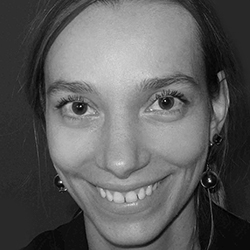Ana G. Petrovic received her B.A. in Chemistry (Summa cum Laude) from Whitman College and her Ph.D. in Physical Chemistry from Vanderbilt University. She completed a three-year combined teaching and research postdoctoral fellowship at Columbia University in the Department of Chemistry prior to joining the Biological and Chemical Sciences Department at New York Tech in 2010. Her overall research interest belongs to the domain of Chiral Chemistry, which involves a combination of chiroptical spectroscopy and molecular modeling techniques to achieve reliable structural elucidations of chiral systems as well as to study chiral induction phenomena. Her research is accomplished through a collaborative network with Columbia University and John Jay College of Criminal Justice. Since joining the New York Tech faculty, she has taught Physical Chemistry, Biochemistry, Engineering Chemistry, Foundations of Scientific Process (FCSC), and has functioned as the FCSC Course Coordinator. In teaching, she is taking an active role in enhancing science core curriculum pedagogy at New York Tech. She is a member of ACS.
Honors & Awards
- Research Travel Award by the Stereochemical Society of Greater New York for attending ISCD-23 conference, June 2011
- New York Tech Travel Grant supporting participation at ISCD-23 conference, June 2011
- New York Tech ISRC Grant, November 2010
- TeraGrid Educational Grant (supercomputing time); Grant #: CHE090045; Project Title: “Structural Elucidation of PNA containing duplexes via Computational Approach”, December 2008
Courses Taught at New York Tech
- Physical Chemistry Lecture and Lab, Fall 2011, Fall 2012
- Biochemistry Lecture and Lab, Spring/Fall 2011, Fall 2012
- Engineering Chemistry, Fall 2010
- Content Coordinator & Instructor of Foundation of Scientific Process, Fall 2010, Spring/Fall 2011, Spring/Fall 2012
Research
- Structural investigations of chiral organic, inorganic and biomolecules via the tandem use of three chiroptical spectroscopic methods: Vibrational Circular Dichroism (VCD), Electronic Circular Dichroism (ECD), and Optical Rotatory Dispersion (ORD). Implementing these methods for reliable structural elucidation of chiral molecular systems is of a major scientific and economic interest due to repercussions of chirality on the development of drugs, agrochemicals, food additives, fragrances, and catalysts.
- Recent involvements in the domain of structural investigations of chiral molecules via chiroptical methods have focused on organophosphorus pesticides and natural products. This research project is a collaborative effort of New York Tech, John Jay College, and Columbia University. Investigating scope, advantages, and limitations of applying dimeric porphyrin tweezers as chirality probes for determining the absolute configuration of diamines and amino alcohols. This research is based on performing supramolecular host-guest complexation studies in tandem with ECD chiroptical investigations and molecular mechanics conformational searches. The project is also a collaborative effort with colleagues at Columbia University and John Jay College.
- Exploring the phenomenon of supramolecular chirality induction on ladder-like molecular architectures. This effort could find utility in the realm of material science and information storage. The ability to induce supramolecular chirality as well as to control the screw-sense and the degree of helicity plays a vital role in the frontier of biomolecular recognition, material science, and information storage. Although helical-induction of single-strand helices has been performed in the past, for example, by covalently adhering enantiopure chiral additives to foldable polymers, the induction of double-strand helices is rare. The double-strand helical structures are frequently found in nature and are closely related to the physiological functions of biomolecules, such as nucleic acids (DNA, RNA, even PNA) and proteins. This research-plan reflects the interest in developing a novel, sensitive tool for helical-sense programming of double-stranded biomolecular architectures.
Selected Publications
- Castro-Fernandez, S.; Yang, R.; Garcia, A. P.; Garzon, I. L.; Xu, H.; Petrovic, A. G.; Alonso-Gomez, J. L.. “Diverse Chiral Scaffolds from Diethynylspiranes: All-Carbon Double Helices and Flexible Shape-Persistent Macrocycles”. Chemistry - A European Journal. 2017, 23(49), 11747-11751.
- Saha, B.; Ikbal, S. A.; Petrovic, A. G.; Berova, N.; Rath, S. P. “Complexation of Chiral Zinc-Porphyrin Tweezer with Achiral Diamines: Induction and Two-Step Inversion of Interporphyrin Helicity Monitored by ECD”. Inorganic Chemistry. 2017, 56(7), 3849-3860.
- Evidente, M.; Santoro, E.; Petrovic, A. G.; Cimmino, A.; Koshoubu, J.; Evidente, A.; Berova, N.; Superchi. S. “Absolute configurations of phytotoxic inuloxins B and C based on experimental and computational analysis of chiroptical properties.” Phytochemistry. 2016, 130, 328-334.
- Petrovic, A. G.; Berova, Nina; Alonso-Gomez, Jose Lorenzo. “Absolute configuration and conformational analysis of chiral compounds via experimental and theoretical prediction of chiroptical properties: ORD, ECD, and VCD”. Book: Structure Elucidation in Organic Chemistry. 2014, 65-104.
- Berova, Nina; Pescitelli, Gennaro; Petrovic, Ana G. and Proni, Gloria. “Probing molecular chirality by CD-sensitive dimeric metalloporphyrin hosts”. Chemical Communications. 2009, 40, 5958-5980.
